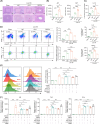Endothelial YAP/TEAD1-CXCL17 signaling recruits myeloid-derived suppressor cells against liver ischemia-reperfusion injury
- PMID: 38407233
- PMCID: PMC11825485
- DOI: 10.1097/HEP.0000000000000773
Endothelial YAP/TEAD1-CXCL17 signaling recruits myeloid-derived suppressor cells against liver ischemia-reperfusion injury
Abstract
Background and aims: Liver ischemia-reperfusion injury (IRI) is a common complication of liver transplantation and hepatectomy and causes acute liver dysfunction and even organ failure. Myeloid-derived suppressor cells (MDSCs) accumulate and play immunosuppressive function in cancers and inflammation. However, the role of MDSCs in liver IRI has not been defined.
Approach and results: We enrolled recipients receiving OLT and obtained the pre-OLT/post-OLT blood and liver samples. The proportions of MDSCs were significantly elevated after OLT and negatively associated with liver damage. In single-cell RNA-sequencing analysis of liver samples during OLT, 2 cell clusters with MDSC-like phenotypes were identified and showed maturation and infiltration in post-OLT livers. In the mouse model, liver IRI mobilized MDSCs and promoted their infiltration in the damaged liver, and intrahepatic MDSCs were possessed with enhanced immunosuppressive function by upregulation of STAT3 signaling. Under treatment with αGr-1 antibody or adoptive transfer MDSCs to change the proportion of MDSCs in vivo, we found that intrahepatic MDSCs alleviated liver IRI-induced inflammation and damage by inhibiting M1 macrophage polarization. Mechanistically, bulk RNA-sequencing analysis and in vivo experiments verified that C-X-C motif chemokine ligand 17 (CXCL17) was upregulated by YAP/TEAD1 signaling and subsequently recruited MDSCs through binding with GPR35 during liver IRI. Moreover, hepatic endothelial cells were the major cells responsible for CXCL17 expression in injured livers, among which hypoxia-reoxygenation stimulation activated the YAP/TEAD1 complex to promote CXCL17 transcription.
Conclusions: Endothelial YAP/TEAD1-CXCL17 signaling recruited MDSCs to attenuate liver IRI, providing evidence of therapeutic potential for managing IRI in liver surgery.
Copyright © 2024 The Author(s). Published by Wolters Kluwer Health, Inc.
Conflict of interest statement
The authors have no conflicts to report.
Figures








References
MeSH terms
Substances
LinkOut - more resources
Full Text Sources
Medical
Miscellaneous

